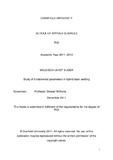JavaScript is disabled for your browser. Some features of this site may not work without it.
| dc.contributor.advisor | Williams, Stewart W. | |
| dc.contributor.author | Suder, Wojciech | |
| dc.date.accessioned | 2012-06-27T10:56:43Z | |
| dc.date.available | 2012-06-27T10:56:43Z | |
| dc.date.issued | 2011-12 | |
| dc.identifier.uri | http://dspace.lib.cranfield.ac.uk/handle/1826/7288 | |
| dc.description.abstract | This thesis undertakes a study of laser welding in terms of basic laser material interaction parameters. This includes power density, interaction time and specific point energy. A detailed study of the correlation between the laser material interaction parameters and the observed weld bead profiles is carried out. The results show that the power density and the specific point energy control the depth of penetration, whilst the interaction time controls the weld width. These parameters uniquely characterise the response of the material to the imposed laser energy profile, which is independent of the laser system. It is demonstrated that by studying the laser welding with respect to the basic laser material interaction parameters also helps explain some phenomenological phenomena in laser welding, such as the effect of beam diameter on the weld profile. In addition a new approach for parameter selection in laser and hybrid laser welding is investigated. A phenomenological model allowing achievement of a particular laser weld on different laser systems is developed. In the proposed method the user specifies the required weld profile, according to the quality requirements and then the model provides combination of laser parameters, which lead to this particular weld on a given laser system. This approach can be potentially used to transfer laser data between different laser systems with different beam diameters. An extensive study of residual stains in laser and hybrid laser welding is carried out. Both processes are compared either at a constant total heat input or at conditions required to achieve the same depth of penetration. The results demonstrate that there is a trade-off between the fit-up tolerance and the residual stress-induced distortion. Hybrid laser welding provides better ability to bridge gaps than the laser welding, but for the price of increased residual stress and distortion. Additionally, industrial study of the sensitivity to fit-up of hybrid laser welding with high deposition rate MIG sources is carried out. This thesis is a part of NEGLAP (Next Generation Laser Processing) project sponsored by EPSRC (Engineering and Physical Sciences Research Council) and Tata Steel. The main objective is to understand the process fundamentals and exploit the usefulness of laser technology in pipe industry. | en_UK |
| dc.language.iso | en | en_UK |
| dc.publisher | Cranfield University | en_UK |
| dc.rights | © Cranfield University 2011. All rights reserved. No part of this publication may be reproduced without the written permission of the copyright owner. | en_UK |
| dc.title | Study of fundamental parameters in hybrid laser welding | en_UK |
| dc.type | Thesis or dissertation | en_UK |
| dc.type.qualificationlevel | Doctoral | en_UK |
| dc.type.qualificationname | PhD | en_UK |
